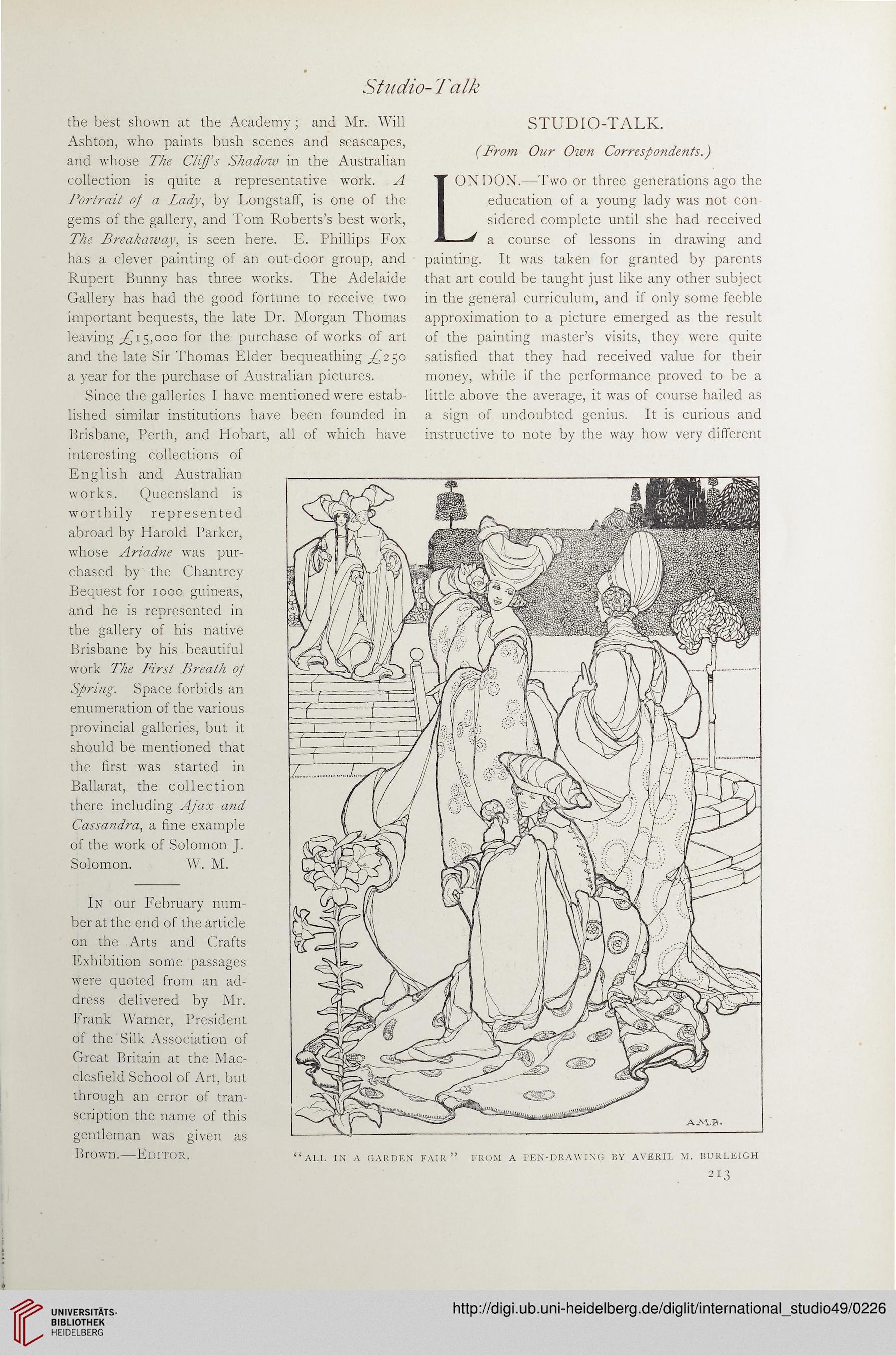Studio-Talk
the best shown at the Academy; and Mr. Will
Ashton, who paints bush scenes and seascapes,
and whose The Cliffs Shadow in the Australian
collection is quite a representative work. A
Portrait of a Lady, by Longstaff, is one of the
gems of the gallery, and Tom Roberts’s best work,
The Breakaway, is seen here. E. Phillips Fox
has a clever painting of an out-door group, and
Rupert Bunny has three works. The Adelaide
Gallery has had the good fortune to receive two
important bequests, the late Dr. Morgan Thomas
leaving Qji 5,000 for the purchase of works of art
and the late Sir Thomas Elder bequeathing ^250
a year for the purchase of Australian pictures.
Since the galleries I have mentioned were estab-
lished similar institutions have been founded in
Brisbane, Perth, and Hobart, all of which have
interesting collections of
English and Australian
works. Queensland is
worthily represented
abroad by Harold Parker,
whose Ariadne was pur¬
chased by the Chantrey
Bequest for 1000 guineas,
and he is represented in
the gallery of his native
Brisbane by his beautiful
work The First Breath of
Spring. Space forbids an
enumeration of the various
provincial galleries, but it
should be mentioned that
the first was started in
Ballarat, the collection
there including Ajax and
Cassandra, a fine example
of the work of Solomon J.
Solomon. W. M.
In our February num-
ber at the end of the article
on the Arts and Crafts
Exhibition some passages
were quoted from an ad-
dress delivered by Mr.
Frank Warner, President
of the Silk Association of
Great Britain at the Mac-
clesfield School of Art, but
through an error of tran-
scription the name of this
gentleman was given as
Brown.—Editor.
STUDIO-TALK.
fFrom Our Own Correspondents.)
T ON DON.—Two or three generations ago the
I education of a young lady was not con¬
sidered complete until she had received
—J a course of lessons in drawing and
painting. It was taken for granted by parents
that art could be taught just like any other subject
in the general curriculum, and if only some feeble
approximation to a picture emerged as the result
of the painting master’s visits, they were quite
satisfied that they had received value for their
money, while if the performance proved to be a
little above the average, it was of course hailed as
a sign of undoubted genius. It is curious and
instructive to note by the way how very different
213
the best shown at the Academy; and Mr. Will
Ashton, who paints bush scenes and seascapes,
and whose The Cliffs Shadow in the Australian
collection is quite a representative work. A
Portrait of a Lady, by Longstaff, is one of the
gems of the gallery, and Tom Roberts’s best work,
The Breakaway, is seen here. E. Phillips Fox
has a clever painting of an out-door group, and
Rupert Bunny has three works. The Adelaide
Gallery has had the good fortune to receive two
important bequests, the late Dr. Morgan Thomas
leaving Qji 5,000 for the purchase of works of art
and the late Sir Thomas Elder bequeathing ^250
a year for the purchase of Australian pictures.
Since the galleries I have mentioned were estab-
lished similar institutions have been founded in
Brisbane, Perth, and Hobart, all of which have
interesting collections of
English and Australian
works. Queensland is
worthily represented
abroad by Harold Parker,
whose Ariadne was pur¬
chased by the Chantrey
Bequest for 1000 guineas,
and he is represented in
the gallery of his native
Brisbane by his beautiful
work The First Breath of
Spring. Space forbids an
enumeration of the various
provincial galleries, but it
should be mentioned that
the first was started in
Ballarat, the collection
there including Ajax and
Cassandra, a fine example
of the work of Solomon J.
Solomon. W. M.
In our February num-
ber at the end of the article
on the Arts and Crafts
Exhibition some passages
were quoted from an ad-
dress delivered by Mr.
Frank Warner, President
of the Silk Association of
Great Britain at the Mac-
clesfield School of Art, but
through an error of tran-
scription the name of this
gentleman was given as
Brown.—Editor.
STUDIO-TALK.
fFrom Our Own Correspondents.)
T ON DON.—Two or three generations ago the
I education of a young lady was not con¬
sidered complete until she had received
—J a course of lessons in drawing and
painting. It was taken for granted by parents
that art could be taught just like any other subject
in the general curriculum, and if only some feeble
approximation to a picture emerged as the result
of the painting master’s visits, they were quite
satisfied that they had received value for their
money, while if the performance proved to be a
little above the average, it was of course hailed as
a sign of undoubted genius. It is curious and
instructive to note by the way how very different
213




